The
Recent History of Bath Spa
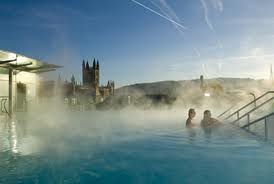
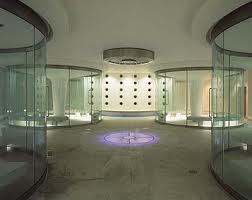
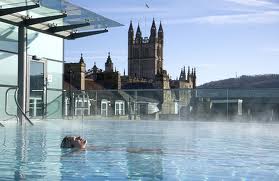
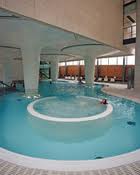
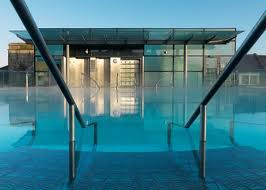
From Newsletter No 49, Winter 2002
Geological
investigations of Bath Hot Springs commenced in 1978 following the discovery of the amoeba Naegleria fowleri in the thermal water installations of the Spa and at a time when the south wall of the Grand Pump Room was undergoing
repair. The presence of the amoeba resulted in the closure of the Hot Bath, the Cross Bath and the drinking fountain in the Pump Room. The King's Bath had already been closed in order to deal with the structural problems relating to the Pump Room.
At the time when these untoward events took place, there was very little information as to the nature of the ground beneath the bed of the King's spring. This spring and, to a lesser extent, the Cross Bath Spring, have always deposited some sand and silt as they emerged at the surface. Such alluvial deposits were shown to come from the Lower Lias Clay which forms the floor of the Avon Valley at Bath. The hot springs of this region issue at or near the margin of the Upper Carboniferous rocks of the concealed Bristol and Somerset Coal‑field.
For the fast time since prehistory, the entire output of the thermal springs of Bath was now running to waste. A plan was drawn up for drilling the bed of the King's Spring in order to ascertain its geological structure and to test the quality of the rising thermal water at depth before it made contact with any contaminated material within or around the spring basin.
Following the removal of the floor of the King's Bath, archaeological investigations revealed the mode of construction of the Roman Reservoir. For the most part the Roman walls are founded on the Lower Lias Clay but where this was not possible, as for example in the channel where the thermal water drained away to the river, the foundations were supported on wooden piles caulked with puddled clay.
The water issuing from the trial boreholes in the Kings* spring gave temperatures up to 46.5 degrees centigrade. Tests carried out at the Pathology Laboratory of the Royal United Hospital at Bath showed no amoeba in the water. Oxidation of the thermal water produces the characteristic orange‑brown stain which can be seen on the stone basin of the Pump Room Fountain. Once oxidation has been completed, the thermal water becomes a potential medium for the growth of the amoeba. Therefore the new Pump Room Fountain has been designed for continuous flow, unused thermal water being immediately drained away to waste. The sinking of the shallow trial boreholes in the basin of the King's spring provided evidence of the temperature, 45.5 C and pressure of the thermal water. The natural ground level of the
King's spring shows that the basin is situated on the alluvial plain of the
River Avon and must therefore have been liable to inundation by the Avon at times of flood.
By building
a massive lead‑lined masonry enclosure with piled and puddled foundations, the Romans effectively isolated the top of the spring pipe from the flood waters of the river.
Following the end of Roman occupation, the buildings of the baths at Aquae Sulis collapsed. The destruction of the strong, well‑founded structure enclosing the Kings Spring is something of a mystery as there is nothing to suggest that subsidence of the foundations of the Roman Reservoir took place, though the foundations of the adjacent Roman Temple do show some evidence of movement. Many of the masses of brickwork were very large and the debris, partly buried by alluvial deposits, partly protruding above the surface of the flood plain, was invaded by the rising thermal water.
With the exception of Wood's Hot Bath, the baths erected in the sixteenth to eighteenth centuries were mainly situated above the hot springs, but some, such as the Kingston Baths in the nineteenth century made use of thermal water which had leaked away through the layer of broken and collapsed Roman masonry
These conditions
prevailed almost unchanged until the end of the nineteenth century when Major C.E.Davis undertook the task of excavating the Roman baths.
It became evident that there was no way in which an acceptable method of extracting sediment‑free thermal water could be devised using vertical boreholes sunk in the floor of the King's spring. Any attempt at extracting thermal water by means of boreholes would therefore have to prove the water' at depth in some structurally stable medium, and recover it without the aid of a filtration plant or special linings requiring frequent cleaning.
The Sports Centre Borehole, 1982
The
possibility
of using thermal water to supply the swimming bath at the Sports Centre was considered by Bath City Council. It also appears likely that the Sports Centre Borehole is situated on the same fault system. It seemed reasonable to hope that the water at the Sports Centre would have a temperature in excess of 26.6 C, this being the temperature required for the baths. A very strong flow of thermal water was encountered but the maximum temperature recorded in this hole was 21 C, a disappointing figure, being about 5.5 C lower than that required for supplying the swimming baths. The slightly brackish or saline taste of the water from the Sports Centre Borehole renders it useless for drinking.
The Stall Street Inclined Borehole, 1983
At the time of the closure of the Spa facilities in 1978, it had already been recognised by the City Engineer that the existing arrangements for pumping and distributing the thermal water from the King's spring were unsatisfactory. The occurrence of the amoeba in the spring basin and thermal installations, notably in the high level storage tank in Swallow Street, now showed that there was also a danger to public health through oxidation of stored water.
Recovery of the thermal water by tapping it at depth beneath the King's spring raised a number of geological and practical problems and several methods were considered in the light of the available information. An inclined borehole sited near
the Pump Room offered the best hope of success. An inclination of 32 C relative to the vertical was adopted in order to pass beneath the estimated position of the bottom of the gravel‑filled spring pipe and to ensure penetration of the hard rocks within the limits of the fissure belt. Drilling of the Stall Street inclined Borehole commenced in April
1983 and it
is from here that water has been extracted to date.
Note: the new spa takes its water from a borehole near the Hot Bath and, thanks to the research described above, should
bring only health to those who use the spring. There is still no firm date for the opening of the Bath Spa. The company Tbermae Bath Spa is now recruiting actively for the opening and already has eight staff Editor
Most of this article is based on chapter 6 of Hot Springs of Bath, edited by G.A.Kellaway, 0 1991 Bath City Council. Chapter authors: S. Kilvington, PG.Mann and D.C.Warhurst.